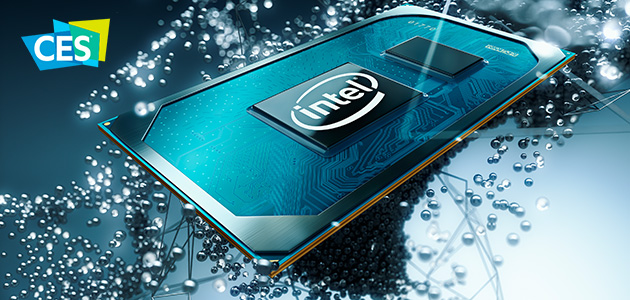Intel Brings Innovation to Life with Intelligent Tech Spanning the Cloud, Network, Edge and PC
Intelligence-Driven Mobile Computing
Mobile computing was an area of emphasis, as Intel made announcements spanning new products, partnerships and exciting platform-level innovations that will transform the way people focus, create and engage. Intel Executive Vice President Gregory Bryant announced the following:
First look and demonstration of the newest Intel® Core™ mobile processors, code-named “Tiger Lake”: Tiger Lake is designed to bring Intel’s bold, people-led vision for mobile computing to life, with groundbreaking advances in every vector and experience that matters. With optimizations spanning the CPU, AI accelerators and discrete-level integrated graphics based on the new Intel Xe graphics architecture, Tiger Lake will deliver double-digit performance gains1, massive AI performance improvements, a huge leap in graphics performance and 4x the throughput of USB 3 with the new integrated Thunderbolt 4. Built on Intel’s 10nm+ process, the first Tiger Lake systems are expected to ship this year.
Preview of first Xe-based discrete GPU: Intel Vice President of Architecture for Graphics and Software Lisa Pearce provided insight into the progress on the new Intel Xe graphics architecture, which will provide huge performance gains in Tiger Lake, and previewed Intel’s first Xe-based discrete GPU, code-named “DG1.”
Significant updates on Intel’s “Project Athena” innovation program, including the first Project Athena-verified Chromebooks: Project Athena-verified designs have been tuned, tested and verified to deliver fantastic system-level innovation and benefits spanning battery life, consistent responsiveness, instant wake, application compatibility and more. Intel has verified 25 Project Athena designs to date, and Bryant announced an expanded partnership with Google that has already resulted in the first two Project Athena-verified Chromebooks, the ASUS Chromebook Flip (C436) and the Samsung Galaxy Chromebook. Intel expects to verify approximately 50 more designs across Windows and Chrome this year and deliver a target specification for dual-screen PCs.
Form factor innovation, including dual screens and a revolutionary foldable design: Through deepened co-engineering efforts with OEM partners, Intel helps deliver category-defining devices based on Intel Core processors. This includes new dual-screen and foldable designs like the Lenovo ThinkPad X1 Fold, which leverages the Intel Core processor with Intel Hybrid Technology (code-named “Lakefield”) expected to ship midyear, and the Dell Concept Duet. Bryant also previewed Intel’s latest concept device, a foldable OLED display form factor, code-named “Horseshoe Bend.” Based on Intel’s upcoming Tiger Lake mobile processors, the design is similar in size to a 12-inch laptop with a folding touchscreen display that can be opened up to more than 17 inches.
Intelligence-Driven Business Transformation
The data center is the force that delivers intelligence to businesses around the world and Intel Xeon Scalable processors continue to be the foundation of the data center. Intel Executive Vice President Navin Shenoy announced that 3rd Generation Intel Xeon Scalable processors, coming in the first half of 2020, will include new Intel® DL Boost extensions for built-in AI training acceleration, providing up to a 60% increase in training performance over the previous family.
1Based on Intel testing and configurations.
Forward-Looking Statements
Statements in this news summary that refer to future plans and expectations, including with respect to Intel’s future products and the expected availability and benefits of such products, are forward-looking statements that involve a number of risks and uncertainties. Words such as “anticipates,” “expects,” “intends,” “goals,” “plans,” “believes,” “seeks,” “estimates,” “continues,” “may,” “will,” “would,” “should,” “could,” and variations of such words and similar expressions are intended to identify such forward-looking statements. Statements that refer to or are based on estimates, forecasts, projections, uncertain events or assumptions, including statements relating to total addressable market (TAM) or market opportunity and anticipated trends in our businesses or the markets relevant to them, also identify forward-looking statements. Such statements are based on the company’s current expectations and involve many risks and uncertainties that could cause actual results to differ materially from those expressed or implied in these forward-looking statements. Important factors that could cause actual results to differ materially from the company’s expectations are set forth in Intel’s earnings release dated October 25, 2018, which is included as an exhibit to Intel’s Form 8-K furnished to the SEC on such date. Additional information regarding these and other factors that could affect Intel’s results is included in Intel’s SEC filings, including the company’s most recent reports on Forms 10-K and 10-Q. Copies of Intel’s Form 10-K, 10-Q and 8-K reports may be obtained by visiting our Investor Relations website at www.intc.com or the SEC’s website at www.sec.gov.
Software and workloads used in performance tests may have been optimized for performance only on Intel microprocessors.Performance tests, such as SYSmark and MobileMark, are measured using specific computer systems, components, software, operations and functions. Any change to any of those factors may cause the results to vary. You should consult other information and performance tests to assist you in fully evaluating your contemplated purchases, including the performance of that product when combined with other products. For more complete information visit www.intel.com/benchmarks.
Contact ASBIS managers in your country to get more information about Intel products.

